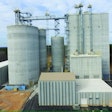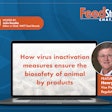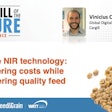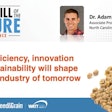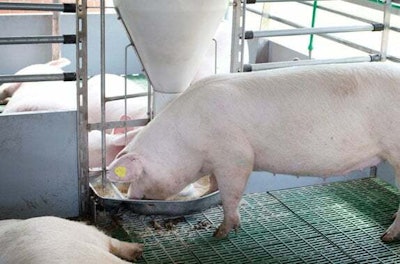
米any savings can be seen on livestock or poultry farms that use real-time feed formulation, from ingredients to labor to greenhouse gas emissions.
Livestock and poultry producers who are looking for a more accurate, efficient and precise way to feed their animals while saving on costs and ingredients may look toward real-time feed formulation.
Real-time feed formulation is a feeding method whereby the correct nutrient balance is fed to individual animals or small groups of animals to meet their real-time nutrient requirements, according to Mohammad Afrouziyeh, research associate at thePoultry Innovation Partnership at the University of Alberta.
This is done by mixing pre-determined diets in the right proportions at the right time, addedAline Remus, research scientist in precision nutritionand metabolism in pigs atAgriculture and Agri-Food Canada.
“For instance, we use a highly concentrated feed which is rich in amino acids, calcium and phosphorus and a very diluted low-concentration feed,” Remus said. “As the animals grow, their individual requirements change over time and among them, and the proportion of high- and low-concentration feeds change over time, to meet these requirements.”
The first step toward real-time feed formulation is creating small groups of animals or birds with similar nutrient requirements for a herd- or flock-level feeding system.
“This approach would closely match nutrient supply to unique nutrient requirements, allowing some tailoring of nutrient supply. This principle could reduce nutrient excretion and increase profit,” Afrouziyeh said.
Karel Vervaet, senior product specialist nutrition atBESTMIX Software, said real-time feed formulation provides the ability to fine-tune each production batch with real-life data, making the formulation process much more accurate and efficient.
Gathering data to fine tune the formula
Thefeed formulation processhas three steps, as Afrouziyeh explained: understanding the nutrient composition of ingredients, understanding the nutrient requirements of animals and formulating the diet to meet the nutrient requirements. For each step, different tools and technology are needed.
For feed ingredient analysis, near-infrared (NIR) scanning technology is commonly used. The nutrient composition matrix in the feed formulation software should be updated according to the captured real-time data by the NIR system, he said.
“It makes it easier for the nutritionist to adjust the feed formula as he gets the information in real time,” Remus said.
On the pig farms she works with, Remus said feeds that are nutrient-rich and -poor are received at the same time for the whole grow-finish process. The feeds are stored in silos and feed lines bring the feed to automated feeders.
To understand the nutrient requirements of animals, a precision feeding system may be used, Afrouziyeh said.
“Precision feeding is defined as providing the right amount of the right feed to the right animal at the right time to achieve a desired objective,” he said. “The desired outcome dictates the composition and quantity of feed required to move an individual from its current state to a preferred state.”
Sensors can be used to identify individual animals and monitor their body weight, body composition and health status, and measure important environmental variables to identify their nutrient requirements in real time. The nutrient requirements can then be transferred to formulation software.
“The more information/knowledge you collect from your animals and their microclimate, the more power you will have to make strategic managerial decisions on your farm,” Afrouziyeh said.
There are different types of feeders for real-time formulation, Remus said, and they need to be able to mix the right amount of feed for each group of animals or each individual animal.
To formulate and blend diets, cloud-based formulation software can use the information from the precision feeding system to formulate a diet that meets real-time nutrient requirements.
“When making the diet, one practical way of adjusting feed formulation would be to use a precision feeding system to blend two or more diets varying in energy-to-nutrient ratios, to provide the correct nutrient balance in real time,” Afrouziyeh said. “Appropriate sensors can be implemented on a precision feeding system to adjust feed amount and composition based on the received real-time data from feed formulation software.”
Remus said a mathematical model is used “to estimate the individual or group requirement on that exact day, and to calculate the proportion of feed A and B to be mixed to create the daily feed to meet the requirements. This information is sent back to the feeders that will distribute the right amount and right composition of feed for an individual or a group of pigs.”
A mathematical model is used to estimate the individual or group requirement and to calculate the proportion of feed A and B to be mixed to create the daily feed to meet the requirements. This information is sent back to the feeders that will distribute the right amount and right composition of feed for an individual or a group of pigs. (Courtesy Aline Remus)
Afrouziyeh pointed out that optimal feeding decisions should consider the three pillars of sustainability: people, profit and the planet, meaning that animal welfare, market conditions and the environmental impact of feeding should be considered.
“Robust feed formulation methods should be chosen based on the right mathematical models used in feed formulation software development,” he said. “More specifically, linear and nonlinear mathematical models are used for least-cost and maximum-profit feed formulation methods, respectively. This requires sophisticated feed formulation software with a multiple-objective formulation ability.
“In other words, if the desire is to minimize the dietary cost, then formulating based on the linear models would suffice, whereas if the desire is to reach/approach the maximum profit, then the product’s price should be included in feed formulation using nonlinear models.”
Tools and technology required
The tools used in real-time feed formulation, such as precision feeding technology and sensors, can target specific areas of nutritional management, according to sources. But, Vervaet said, access to the cloud – available anywhere at any time – is a must for using most of this technology, and formulation software must be interconnected with other software.
By collecting big data, robust nutrient intake models can be developed to formulate diets with optimum levels of nutrients.
“For instance, energy or amino acids requirement-predicting models have been used to establish optimized levels of dietary nutrients and more profitable feeding programs for livestock animals,” Afrouziyeh said. “These animal models should be incorporated into precision livestock farming systems. These integrated systems should run in real time to evaluate individual animals’ needs and electronically control feeding systems to adjust feed composition and intake to meet each animal’s needs.”
Remus’ team targets individual lysine, calcium and phosphorus in pigs, resulting in a more than 40% reduction in excretion of nitrogen, phosphorus and other polluting constituents of manure. Depending on the situation, she said, lysine intake can be reduced from 15% to 27%.
Saving on nutrients and other feed ingredients can no doubt save money as well, Vervaet said.
“The more accurate the data you formulate with, the more precise the formulation tool can optimize the requests from customer/nutrition department,” he said. “As such, you deliver what you promise, no more, but also not less, and you will make the formulation process more efficient, both in amount of materials you require, as in the cost price of the products you formulate.”
Remus cited other savings, as well, from production costs to greenhouse gas emissions, and added that use of automated feeders also results in very little feed waste and less labor requirements and related costs.
“By producing two standard feeds in the feed mills, and delivering only two feeds to the farms, we could imagine a potential savings related to production, formulation and transport,” she said. “There is a potential decrease in CO2emissions as well that we are studying at the moment. For instance, instead of formulating three-phase feeds, the formulation of feed A and B can reduce feed manufacturing, storage, handling and shipping costs by 2-3% by using the same two or more premixes on all farms.”
A cost-benefit analysis should be conducted before moving to real-time formulation and precision livestock farming, Afrouziyeh said, including every possible outcome in the economic analysis.
“乍一看,增加饲养成本由于to the precision livestock farming system implementation might be intimidating; however, the benefits of the outcomes should be carefully considered,” he said. “For instance, it has been found that using the precision feeding system in broiler breeder operations can eliminate the need formale spiking,” or the introduction of male broiler breeders into a flock in an effort to improve flock fertility.
The future of real-time feed formulation
While there has been some hesitancy to adopt real-time formulation in the past, Remus said research has shown the benefits of adapting this technology.
“The pressure to decrease environmental impact and the difficulty to find workforce to work in farms (means) people will start to adopt this type of technology,” she said. “As well, future generations of farmers want work that better matches their abilities, and smart farming can give them these tools.”
Afrouziyeh agreed that the livestock industry is likely to move toward precision livestock farming and smart animal nutrition, using big data to optimize real-time management and feeding decisions.
“To undergo this process, the industry and the research community need to shift their focus from feeding and managing large flocks to feeding and managing individuals. Achieving the objective of matching nutrient supply to the nutrient requirements of individual animals is a novel concept in animal nutrition, especially for the poultry industry.”
Feed Mill of the Future digital supplement
WATT’s feed brands Feed Strategy and Feed & Grain magazines join forces to launch the monthly Feed Mill of the Future digital supplement. Each edition aims to provide animal feed industry stakeholders with forward-looking content, market insights and a spotlight on the leading-edge technologies shaping the global feed industry of tomorrow.
Subscribe today!https://bit.ly/3dWzow7











